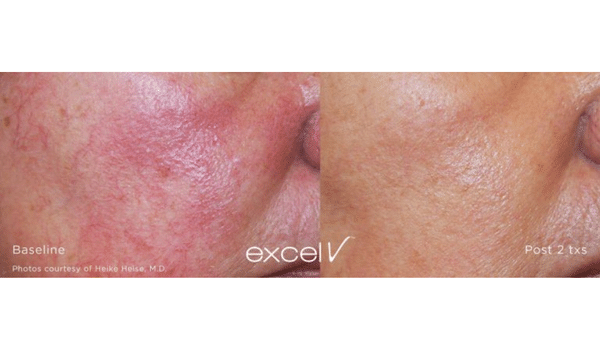During this time of year with colder weather, you may be more likely to deal with facial redness. Facial redness can be irritating, and it can cause a decrease in self-esteem. Identifying the cause and best treatment for facial redness can help you boost your confidence and get your skin back to its healthiest state. Read on to dive into the causes of this condition, the best treatment for facial redness, and more!
What Causes Facial Redness?
There are many causes of facial redness, including the cold winter weather. And, thinking back to warmer weather, the sun. If you are constantly trying to cover up this condition, it might be due to more than the weather. Some other common reasons for facial redness are:
-
Seborrheic dermatitis
Seborrheic dermatitis is a common skin condition that is often characterized by a red rash forming on your face. The skin can appear oily but may actually be dry and scaly. This can often look like psoriasis, eczema, or an allergic reaction. That’s why it’s best not to self-diagnosis. Your dermatologist can best diagnose and treat seborrheic dermatitis by reviewing your medical history and closely examining the affected area.
-
Rosacea
Rosacea, while common, can often go undiagnosed. Many people confuse rosacea for a tendency to easily blush or become flushed. If your face becomes flushed when you are stressed, consuming alcohol, feeling too warm, or eating spicy foods, these may be early signs of rosacea. The flush or blush associated with rosacea often begins to form from the nose outwards. As the skin condition progresses, you may notice more of your face becoming flushed or the flushed look staying longer.
-
Allergic Reaction
Did you know that allergic reactions can cause facial redness? You bet, they can. Allergic reactions can be caused by many different things, including poison ivy, laundry detergent, and medication. If you are suddenly experiencing facial redness, take an inventory of your daily routine and see if anything new has been added. If not, begin to pay attention to when your facial redness appears. Believe it or not, your body can suddenly become irritated by a product you have used for years.
-
Atopic Dermatitis
Atopic dermatitis is most commonly known as a type of eczema. Eczema is well known for causing facial redness, especially during the winter when harsh winds and below freezing temperatures more easily irritate your skin. The redness that appears from eczema can be itchy and will appear dry and scaly.
-
Psoriasis
If your facial redness occurs alongside joint problems during periods of stress, psoriasis may be to blame. What is psoriasis exactly? Psoriasis is a condition that occurs when your body makes new skin cells over a period of days rather than over a period of weeks. These new cells cluster and appear as raised, scaly patches.
What is the Best Treatment for Facial Redness?
The best treatment for facial redness for each person will vary based on the cause of your facial redness. If your facial redness is due to an allergic reaction, stop bringing your skin into contact with that irritant as soon as possible. You can apply a cold compress to the affected area, as well as an anti-itching cream. While your skin is irritated, use products that are fragrance-free. In addition, gently and cautiously apply products to your skin. Do not rub your skin with abrasive towels or exfoliants. If your redness persists, then it is time to see a dermatologist.
If your facial redness is caused by any of the skin conditions mentioned above, a treatment regimen prescribed by your dermatologist is needed. The best treatment for facial redness will be determined by your age, where the affected area of skin is located, and how severe the skin condition is. A few dermatologist recommended treatment options for facial redness are:
-
Topical Products
Depending on your skin condition, your dermatologist can prescribe a number of topical treatments. For conditions such as seborrheic dermatitis, you dermatologist can recommend a combination of dandruff shampoo, anti-itch creams, and a barrier repair cream. Depending on the severity of your rosacea, a topical treatment for rosacea may be prescribed. These can include Azelaic Gel or acne wash.
-
Prescription Drugs
If topical treatments are not working, then your dermatologist may prescribe medications to help reduce your facial redness. Medications such as Methotrexate and oral retinoids may be prescribed to help manage psoriasis. Prescription drugs are also commonly found in a rosacea treatment regimen.
-
Laser Treatment
For some people, laser or light treatments may be needed to help reduce facial redness. Laser treatment is often used to diminish the appearance of veins in the face, which aids in reducing facial redness. At Vujevich Dermatology, we use the Excel V Laser for our laser treatments.
-
Light Therapy
Light therapy, also known as phototherapy, is often used in the treatment of eczema. Phototherapy is a safe and effective way to reduce redness in both children and adults. Phototherapy can be cumbersome as you will need to attend 2-3 appointments per week up to a few months to see lasting results. Your dermatologist will discuss your options with you to create the best treatment plan for you.
If you have persistent facial redness, schedule an appointment your dermatologist to discuss your best treatment for facial redness that is specific to you. Vujevich Dermatology Associates offers medical, surgical, and cosmetic dermatology from some of the most highly trained physicians and clinicians in the greater Pittsburgh area. You can reach our team at 412-429-2570 or visit our contact page to see all of our locations. You can also follow us on Facebook to see what’s new in the world of dermatology.

